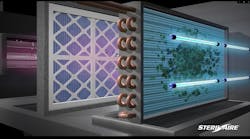Our company was involved in a project to renovate an existing hospital space to make way for a new pharmacy. Our first task involved a visit to the space to formulate our design intent and familiarize ourselves with the existing system conditions. Ductwork routing and mechanical-system components seemed to match the as-built documents closely, with a few minor in-house modifications that had been done in the past.
The only item that troubled us involved the outside-air system serving the air-handling unit (AHU) we planned to reuse. To bring outside air into the building, the AHU pulled outside air from a wall louver that was ducted back to the AHU mixing section, where outside air was remixed with return air from the plenum. Because the hospital had been built in different phases with different design firms and contractors, somewhere in the mix, a building had been built that butted up against the wall that housed the outside louver serving our unit.
When the situation was brought to the plant manager's attention, he was surprised to hear that an item such as this could be overlooked. He assured me that the contractors must have found another routing for the ductwork up to the roof or perhaps through the crawlspace that ran under both buildings. We scoured the roof and crawlspace, but had no luck.
We checked the operation of the manual outside-air damper, but found it was fully open. We then decided to check the building-control-automation system (BCAS) to see if the outside temperature was monitored, but, of course, only the discharge temperature was displayed.
At one point, the building plant manager suggested we knock the ductwork off the wall to see if the louver had been blanked off. Rather than begin the demolition phase early, I suggested we poke a small hole in the outside-air duct-work and insert a hand-held temperature sensor. With an afternoon ambient temperature of 45°F, we knew the sensor should have read somewhere in that vicinity. To our knowing disbelief, the sensor read a whopping 72°F — the set-point temperature of the space. We realized that the space had lacked outside air since the expansion phase, which had occurred 25 years earlier.
Luckily, we had to deal with only two stories and an existing chase. We ran an outside-air duct, complete with a new motorized outside-air damper, intake hood, and outside-air temperature sensor, up to the roof.
Send “war stories” of 400 or fewer words to the attention of Scott Arnold, managing editor, at [email protected]. Authors are paid $50 per published war story.








